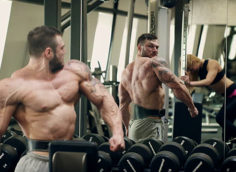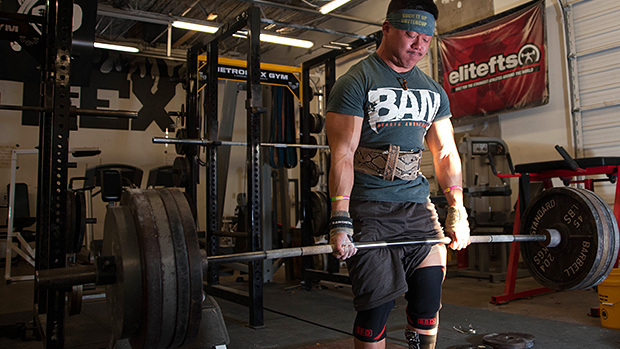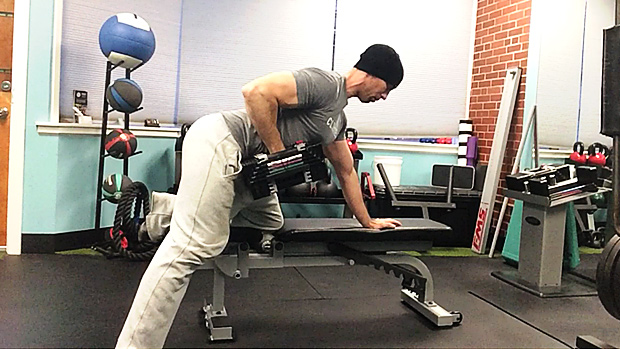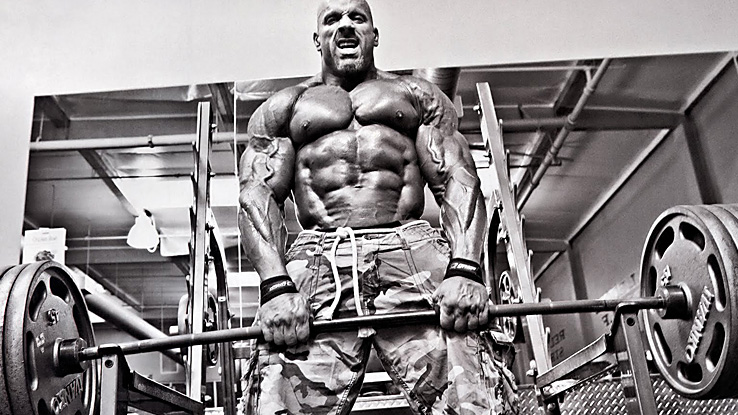While I typically try to avoid sweeping training generalizations like a Kardashian avoids a classroom, I'm perfectly comfortable with the following: everyone would be wise to include some form of single-leg work in their training program.
I'm not saying that everyone should train the same way, or even that everyone should do single-leg work the same way. I'm just saying that single-leg work will benefit just about everyone.
How you ultimately chose to employ your single-leg work, however, will (and should) vary largely based on your training goals. This article will go into how to implement single-leg work into your program to match your individual needs.
Before I get into how to program single-leg work for specific populations, I'll first address how to even out imbalances between legs, as that's a common goal for many irrespective of their overall training goals.
Let's start by distinguishing between size imbalances and strength imbalances because while they're both connected, the prescription for fixing them is different. Realize though that most people are always going to have slight imbalances between legs in both size and strength, so don't expect to be perfectly symmetrical, but steps can certainly be taken to improve upon your current state and become as even as possible.
For size discrepancies, the best thing is just to add slightly more volume for the smaller leg. For example, if your left leg is smaller than your right leg, start and finish your single-leg exercises with your left leg, giving you one extra set per exercise.
So if your program calls for 3 sets of 8 reps of split squats, start on the left leg and then alternate between legs for all three sets before finishing with an extra set on the left, for a total of four sets on the left leg and three sets on the right leg.
For strength discrepancies, there are a few ways you can go about addressing it.
- Do the weaker leg first and match the reps on the stronger leg.
- Do the stronger leg first and then do an extended "rest-pause" set on the weaker leg to match the stronger side. Do as many reps as you can, rest briefly, and go again until you match the reps.
For glaring strength differentials – more than five reps difference between legs – or when coming off an injury, I suggest using approach number 1. A rest-pause set would be impractical as it would take too many mini-sets to match the strong leg, and pushing it too hard when coming off an injury is unwise because the potential for re-injury is too high.
For small strength differentials, however, I prefer approach number 2. This let's you keep pushing the stronger leg to get even stronger while simultaneously forcing the weaker leg to catch up.
When I was using this strategy several years back, I'd also add a couple extra reps on the weaker leg, just for good measure. Using this strategy, I was able to quickly even out my leg strength without ever having to go easy on the strong side.
With that out of the way, let's get to how to program single-leg work for different training populations.
The single-leg newbie is someone with no prior experience with single-leg work. Regardless of your overall training goals, if you're new to single-leg training, start here.
The key to long-term single-leg training success is to start with the most basic exercises and progress only when you've mastered the previous step. This seems so blatantly obvious that it really shouldn't even need to be mentioned, but it's amazing how many people will jump right into a pistol squat without ever having done any single-leg work and then wonder why they a) can't do it right away, or b) got hurt.
Generally, start with supported single-leg work before progressing to unsupported single-leg work.
Supported single-leg work means a unilateral exercise that biases one leg over the other, but where the non-working leg still offers stability. Examples, in order from easiest to hardest, would be split squats, Bulgarian split squats, and lunges.

Unsupported single-leg work would be any exercise that's done exclusively on one leg, Examples, from easiest to hardest, would be single-leg squats to a bench, skater squats, and free-standing single-leg squats.
Follow the steps and be patient. It won't take as long as you might expect to become proficient if you follow those progressions, but if you get greedy and try to skip steps you'll most likely just spin your wheels, get frustrated, and conclude that single-leg work is dumb.
Lastly, it's important that you do your single-leg work at the start of your workout when you're fresh because it's significantly harder to learn in a fatigued state since stability will be compromised.
Once you're more comfortable with the exercises you can switch around the order a bit to fit your goals (more on that to come), but do your single-leg work first in your workout, at least in the beginning. It'll drastically expedite the learning curve and save you a lot of wasted effort.
Single-leg strength and stability are extremely important for athletes for both performance and injury reduction and thus should be made a big priority.
Single-leg strength is best achieved through supported single-leg exercises as the added stability of the non-working leg allows for greater loads to be used, while unsupported exercises are better for developing stability. As such, it's best to include a mix of both supported and unsupported work.
That's not to say that you shouldn't also include bilateral lower body strength exercises too, as I think it's ideal to have a good balance of unilateral and bilateral strength. If a guy can squat 400+ pounds with ease but struggles to do an athletic looking lunge and can't do a single-leg squat to save his life, he's leaving a lot on the table.
However, if someone can balance on one leg with the best of 'em yet just isn't that strong overall, that's not good either. I go into this in much more detail in Is Your Leg Strength Up to Snuff?.
Practically speaking, if you train your legs twice a week – a good starting point for athletes – this might mean starting one workout with a heavy bilateral hip dominant exercise and finishing with a lighter unsupported knee dominant exercise, and then starting the other workout with a heavier knee dominant exercise and finishing with a lighter bilateral hamstring exercise. For example:
- Day 1: Deadlifts followed by single-leg squats
- Day 2: Bulgarian split squats followed by glute-ham raises or sliding leg curls
Or you could pair a heavy bilateral knee dominant exercise with a lighter unilateral hip dominant exercise one day and then follow that with a unilateral knee dominant exercise with a heavier bilateral hip dominant exercise the next workout. For example:
- Day 1: Front squats followed by single-leg Romanian deadlifts
- Day 2: Reverse lunges followed by Romanian deadlifts or hip thrusts
The possibilities are endless as far as programming goes so don't limit yourself to the examples above, but hopefully you get the idea.
For powerlifters and Olympic lifters, single-leg work comes secondary to bilateral work for obvious reasons, but that doesn't mean it doesn't have a place in the mix. It certainly shouldn't be a focal point, but it can provide some valuable assistance work.
Since the brunt of the heavy strength work is centered on bilateral lifts, though, the primary focus on the single-leg work should be more on promoting balance between legs and developing the stabilizing muscles in the hips that get overshadowed during bilateral exercises.
A lot of people that have spent the majority of their training careers banging away at heavy bilateral work will often struggle tremendously with single-leg work right out of the chute, but that's all the more reason to practice it and get better at it to help shore up weak links.
Unsupported single-leg work can strengthen the hip stabilizers, but very few strength athletes – especially bigger dudes – will be able to do unsupported exercises at first, so it's important to start from the beginning with basic split squats and go through the steps just like everyone else.
Just because you're super strong bilaterally doesn't mean you'll automatically be good at single-leg work, so be prepared to be humbled at first. The good news is that you won't be tested on your single-leg strength, so don't get too caught up in the weight and take the time to learn it the right way.
Single-leg work can also be useful for strength athletes as a way to work their legs while giving the lower back a break from such heavy loads.
For example, many powerlifters find that they can't squat and deadlift in the same workout for long without burning out or overburdening their lower back. In that case, you could deadlift heavy and finish with something like walking lunges or skater squats, or start with heavy squats and finish up with some single-leg Romanian deadlifts.
Bilateral work should be done first in the workout since that's of primary importance, but make sure to include some unilateral work too afterwards – maybe not every workout necessarily, but at least once a week.
This doesn't just mean competitive bodybuilders, but anyone whose sole focus is on building size.
When size is the primary goal, supported single-leg work is essential due to the increased stability it provides as compared to unsupported exercises. The more the stabilizers have to work, the less the prime movers – in this case the quads and hamstrings – work. Conversely, the less the stabilizers have to work, the more the prime movers can do.
Considering that the prime movers have much more potential for growth, you want to minimize the stability demands for hypertrophy-related purposes.

In that case, why do single-leg work at all? Why not just squat?
That's a good question, to which I have three answers:
- To help develop and maintain symmetry between legs since most people have a size disparity if they've been neglecting single-leg work, as there's often a tendency to favor one side slightly during bilateral work.
- Once you get good at single-leg work and can handle heavy loads on things like Bulgarian split squats and lunges, you have the potential to overload your legs more than you can during bilateral squatting because you don't have to contend with the lower back being the limiting factor. Greater overload in turn leads to potentially more growth.
- Single-leg work allows you to train your legs more frequently because it doesn't tax the system as much since the overall loads are lower. Greater frequency in turn leads to potentially more growth.
That's not to say you shouldn't squat or do any other bilateral lower body work too – it means you shouldn't just squat and do bilateral lower body work exclusively because you'd be squandering some potential leg growth. Mixing heavy split squats and lunges with bilateral squatting variations would likely yield the best results.
I prefer to do the unilateral work before the bilateral squatting for several reasons.
Due to the increased stability demands, it's much harder to do single-leg in a fatigued state than it is to squat in a fatigued state. When you squat in a fatigued state you'll have to drop the weight a bit, but it won't negatively alter the execution of the exercise.
However, when you try to do single-leg work in a fatigued state you'll find you have to drop the weight much more and the stability component becomes much harder than if you'd done it when fresh, so it becomes more of a balance drill than a strength exercise.
Furthermore, the single-leg work serves as a good "pre-exhaust" technique for squatting because it allows you to smoke your legs without fatiguing the upper and lower back as much. The legs are the limiting factor, which is what we want seeing as we're trying to work our legs.
In this sense, rather than thinking of single-leg work as some "functional" mumbo jumbo, you could really think of it as leg isolation work, much like a bodybuilder might traditionally use leg extensions at the start of leg workouts – only heavy single-leg work allows you to use a whole heck of a lot more weight than leg extensions and, when done correctly, is much safer for the knees.
Most people will notice that when they do heavy squats at the start of a workout, the lower back is the limiting factor. With front squats, it's the upper back and core.
If you do your single-leg work first, though, you'll have to drop the weight a bit on your squats since you've already tired out your legs considerably, but since you haven't tired out your back, you can squat with better technique and your back won't give out first, allowing your legs to become the limiting factor again – which is what we're after.
I'm also a big fan of using a few higher-rep sets at the end of a leg workout when size is the goal. Heavy low-rep work is where it's at for strength purposes, but you can't beat mid-high rep work for leg size.
Logistically speaking, bilateral squatting lends itself much better to higher-rep work because stability isn't a factor. With high-rep single-leg work, balance usually becomes the limiter, whereas that's not as much of a factor with low-moderate rep work once you're proficient.
Lastly, finishing with bilateral work is a good strategy for those newer to single-leg training because it allows you to practice the single-leg work when you're fresh, but then let's you finish off your legs with exercises you're more comfortable with so you still get a good training effect.
So rather than do heavy squats followed by light single work, try inverting the order and doing heavy-moderate rep single-leg work (5-8 reps per set) followed by moderate high-rep (8-30 reps per set) bilateral work.
You should be able to train your legs 2-3 times a week using this method as opposed to many traditional bodybuilding approaches that have you hitting legs once every 5-7 days.
The Average Joe isn't a competitive athlete anymore, but he (or she) still likes to play sports on occasion and still likes to feel somewhat "athletic." He doesn't compete in strength sports but still likes to push himself in the gym and get stronger, though he doesn't care as much about his one-rep maxes and isn't married to any particular lifts. He's not a bodybuilder, though he does want to put on some more muscle and look better.
He's also banged up from his years as an athlete and just life in general, which he's compounded with crappy lifting technique and poor programming. He's not ready to pack it in and quit lifting and join the ranks of all the other lazy and out-of-shape dudes that he sees slugging around him, but he still has to pay heed to his injuries because with a job on the line, he can't afford to be hurt all the time.
For the Average Joe, single-leg work is a godsend because it allows you to push yourself hard, feel athletic, get stronger, and build muscle without beating your joints up as much, which is more conducive to long-term health and success.
You can still do the bilateral exercises you enjoy doing because, after all, training should be enjoyable. I'm as big a proponent of single-leg training as you'll find, but I still trap-bar deadlift the regular way just because I love doing it.
The point is just that you'd be wise to start sprinkling more single-leg work into your program to replace some of your heavier bilateral exercises, but it's okay to keep a few in there that you really like doing and can do without pain.
But if there's an exercise you hate doing but think you have to because you've read it somewhere, or if you keep getting hurt doing an exercise but keep coming back to it because you think it's essential to your "gains," give some single-leg work a shot in its place and see how you feel. I think you'll be very happy with the results.
The main takeaway for the Average Joe is just to realize that single-leg work is an effective and viable way to make progress and isn't just some foo-foo garbage.
Hopefully I've given you some ideas about how to make single-leg training work for you. It's now on you to do the work.
I think some people have the idea that single-leg training is somehow taking the easy way out. Whenever I hear this, I know that person has never really pushed single-leg training hard, because I can tell you it's anything but easy when you do it right. It's well worth the effort, though.





